Daily News
by Gail Helmer
[ Send Us News | Archives ]
Uncommon Valor Ships
Matrix Games has announced that Uncommon Valor: Campaign for the South Pacific is now shipping. Co-developed with the legendary Gary Grigsby, Keith Brors and Joel Billings of 2 by 3 Games, Uncommon Valor is a completely new operational game covering the campaign in the area around Australia, New Guinea and Guadalcanal during World War II. Uncommon Valor features scenarios in the South Pacific from May, 1942 through December, 1943, AI for solo play and Secure PBEM mode for battles against human opponents, editor included for scenarios and units.
Operation Flashpoint: Resistance Movie
Codemasters has released a pre-E3 teaser trailer for Operation Flashpoint: Resistance the expansion to Operation Flashpoint: Cold War Crisis, developed by Bohemia Interactive Studio. Enhancing the Flashpoint universe, Operation Flashpoint: Resistance creates an additional 100km2 island complete with industrial-style buildings and original landscape scenery. Thanks to the use of high-resolution textures throughout, the visuals will be much more detailed and dramatic than ever before.
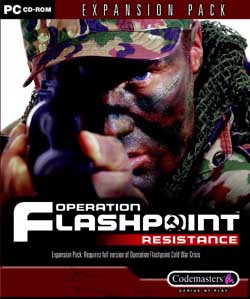
The expansion also delivers a new campaign that forms a prequel to the original game’s plot and is set years before Operation Flashpoint’s Cold War hit crisis point. All the events in the Resistance campaign are closely linked. As players progress through the campaign, the amount of equipment, ammunition and fellow soldiers persists from one mission to another. Tactical use of supplies comes into play as there’s no telling what lies ahead. In addition to the new campaign, the expansion offers enhanced network code, incorporating an in-game server browser system and completely overhauled communication code for better multiplayer performance.
Operation Flashpoint: Resistance requires the original game to play and is set to launch in June. The 13Mb trailer can be download in MPEG format from: Download Site 1 or Download Site 2
Real War: Rogue States Announced
Simon & Schuster Interactive has revealed Real War: Rogue States, its upcoming sequel to the real-time strategy game Real War. Like its predecessor, Rogue States will let players go to war against the Independent Liberation Army, a fictional modern-day terrorist organization. The game will feature 14 new single-player missions, 20 new skirmish maps, and a number of new multiplayer options. Some of the new skirmish maps will focus specifically on different types of games, such as air-only maps, counterterrorist maps, and advanced tactics maps. The game's new multiplayer options will let two players share control of the same forces, with one player controlling the ground forces and the other player controlling the air forces. Rogue States will also improve on its predecessor with a new artificial intelligence system that lets players give units orders to complete specific objectives. Release Date: September 2002. Previous coverage.
Military News
Northrop Grumman Continues Work On QSP
Northrop Grumman Corporation's Integrated Systems sector has been awarded two Phase II contracts by the Defense Advanced Research Projects Agency (DARPA) to continue its work on the Quiet Supersonic Platform (QSP), a program designed to lay the foundation for efficient and capable long-range supersonic aircraft that will operate with a less intense sonic boom.
Under one of the contracts, for systems studies and technology development, Northrop Grumman will validate and demonstrate the quiet supersonic concepts it defined during the first phase of the QSP program. This contract, valued at $2.7 million, includes wind-tunnel testing of a scale model of Northrop Grumman's preferred QSP aircraft concept.
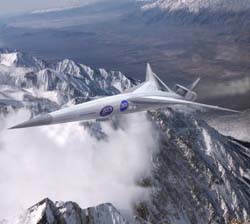
In addition, Northrop Grumman will work with Raytheon Aircraft on the fabrication and testing of a structural component made with an advanced composite core. Northrop Grumman's previous QSP systems studies work was performed under a Phase I contract awarded in 2000.
The other contract, valued at $3.4 million, is for additional work on the first flight demonstration of a sonic boom mitigated by aircraft shaping. The flight test, scheduled for this fall, will use a Northrop Grumman F-5E aircraft with a modified forward fuselage to produce a shaped sonic boom that is expected to be noticeably quieter than a conventional sonic boom. Northrop Grumman's work on the sonic boom demonstration began under a DARPA contract awarded in July 2001. Work on both contracts is expected to conclude at the end of December 2002.
F-15E Launches Five GBU-31 JDAMs on Single Sortie
A U.S. Air Force F-15E has demonstrated its strike capability by launching five Boeing [NYSE: BA] GBU-31 Joint Direct Attack Munitions, or JDAMs, during testing at China Lake, Calif., successfully attacking five separate targets.
The aircraft, launched from Edwards Air Force Base, Calif., was from the 416th Flight Test Squadron. The ripple release of the five, 2,000 lb. JDAMs occurred from level flight at 25,000 feet and a speed of 0.80 Mach over the target range. This was the final JDAM guided-release mission for the F-15E Smart Weapons Integration. The JDAM has been integrated on B-1, B-2 and B-52 bombers as well as F/A-18, F-16 and now F-15E aircraft.
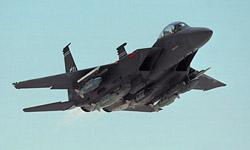
Boeing is currently building at its St. Louis facility 10 F-15E aircraft for the Air Force. Those will increase to 236 the total number of E models delivered. The F-15E is the most capable multirole fighter aircraft currently operated. It is capable of carrying more than 23,000 pounds of air-to-air and air-to-ground weapons and can fly at twice the speed of sound.
Last month, the Republic of Korea selected the F-15K as its F-X fighter. The F-15K is an advanced derivative of the F-15E that the U.S. Air Force operates. Production of the 40 F-15Ks will augment the 10 F-15Es now in production. The first F-15K will be delivered in 2005; the last F-15K now on order will be delivered in 2008.
Boeing is under contract for more than 50,000 JDAM kits in the GBU-31 (v) 1B/3B (2,000 lb. MK-84 general purpose (GP) / BLU-109 penetrator), GBU-32 (1,000 lb. MK-83), and GBU-35 (1,000 lb. BLU-110 GP) configurations. The GBU-38 (500 lb. MK-82 GP) JDAM is in development and undergoing flight testing. The JDAM line is producing 1,500 JDAM kits per month.
F-22 Concludes Ground-Based, Full-Scale Static Testing
The Lockheed Martin Aeronautics Co. led F-22 industry team has successfully completed all planned static testing of the F-22, demonstrating that the structural integrity of the airframe can withstand forces 50 percent higher than those expected in service life.
This milestone completes almost three years of full-scale static testing on Raptor 3999 -- one of two non-flying F-22 airframes located at Lockheed Martin Aeronautics' facility in Marietta, Ga.
"The unprecedented success of this static testing is testament to the sophisticated tools and talents of the dedicated engineers who designed the F-22," said Bob Rearden, Lockheed Martin Aeronautics Co. vice president and F-22 program general manager. "Successfully completing these tests gives the Air Force great confidence that the F-22 will meet or exceed all expectations for structural integrity."
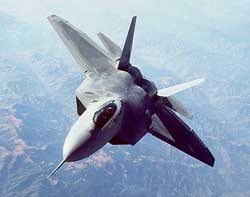
Since 1999, Raptor 3999's airframe has been subjected to loads applied by numerous hydraulic rams designed to simulate forces the aircraft actually encounters during flight. This testing is done primarily to demonstrate the structural integrity of the airframe.
Unlike many fighters designed in the past, the F-22 fly-by-wire flight control system is optimized for maximum performance for all points in the sky. This required many more test cases to be run to ensure all corners of the flight envelope were tested.
The Raptor will replace the venerable F-15 Eagle as America's premier front-line fighter jet starting in 2005. The F-22's balanced design of stealth, supercruise speed, and super-agility, along with its advanced integrated avionics and overall user-friendliness, will allow the F-22 to help shorten future wars and save American and allied lives.
AAR to Support Comanche Helicopter
AAR announced today that AAR Composites, a division of its Manufacturing Group, has been awarded a contract by Lockheed Martin for fabrication and subassembly of advanced composite and carbon fiber structures for the Electro-Optical Sensor System (EOSS) for the Comanche helicopter. Lockheed Martin
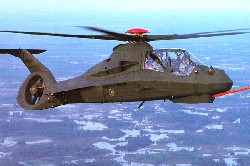
Missiles and Fire Control in Orlando, Florida, is developing the EOSS. The RAH-66 Comanche helicopter is the U.S. Army's 21st century combat reconnaissance and attack helicopter being developed by the U.S. Army's first team lead by Boeing Rotocraft and Sikorsky Aircraft Corporation. The EOSS is an integral part of the Comanche Target Acquisition System (TAS) and the night and adverse weather pilotage system.
KVH FOGs for Stinger and ITAS Training Simulators
KVH Industries fibre optic gyros (FOGs) have been selected by the US military to provide motion tracking, visual stabilisation, and image synchronisation for the Stinger and Improved Target Acquisition System (ITAS) training simulators. KVH gyros will be used to upgrade existing Stinger shoulder- and tripod-mounted simulators while the tripod- or vehicle-mounted ITAS simulator is an entirely new system. KVH currently supplies FOGs for use in the Javelin Basic Skills Trainer, an order that was originally announced in November 2000.
The Stinger, ITAS, and Javelin simulators are designed to operate in the same way as the actual missile launchers. A digitised battlefield is displayed in the simulator's targeting scope and, as the soldier moves the simulator to track and fire on a potential target, the battlefield image moves correspondingly, offering a realistic battlefield environment. At the same time, the instructor can view and influence the same virtual image on a computer screen to vary the timing and types of targets while monitoring and evaluating a trainee's performance.
"The use of virtual reality-based simulators offers an invaluable yet cost-effective training tool," remarked Jay Napoli, KVH's director of FOG/OEM sales. "Contrary to what you might see in the movies, the Javelin anti-armour, Stinger ground-to-air, and ITAS anti-tank missile systems are complex weapons that are not simply hoisted to your shoulder, pointed at a target, and fired. By carrying out training with these simulators, which look, feel, and act like the real thing, .. soldiers can be trained to a very high degree. Virtual reality simulators like these have been shown to significantly increase the percentage of successful hits during live fire exercises."
E-Core FOGs use KVH's proprietary polarisation-maintaining optical fibre and fibre components and are highly reliable systems with no moving parts to wear out or require maintenance. FOGs provide extremely precise rotational rate information by measuring the phase difference between two paths of light travelling in opposite directions through an optical fibre. Their precision results in part because of their lack of cross-axis sensitivity to vibration and acceleration. KVH FOGs also have low noise and high bandwidth, essential to motion tracking and image stabilisation applications. Currently, KVH Industries' FOGs are fielded in a wide array of defence-related applications ranging from optical, radar, and antenna aiming systems to battlefield tactical navigation systems and turret stabilisation.
Weapons Cache Including 5 Tanks Confiscated in Afghanistan
U.S. forces operating in Afghanistan confiscated five Soviet-made tanks in what might be the largest cache of weapons found to date in the country. Marine Gen. Peter Pace, vice chairman of the Joint Chiefs, told reporters in the Pentagon today that U.S. troops found large caches of weapons "over the weekend" in Orgun, near the Pakistan-Afghanistan border south of Gardez, and in Herat, in the western part of the country.
He said the haul included more than 800,000 rounds of .50- caliber ammunition, 1 million machine gun rounds, 600 rocket-propelled grenades, 700 mortars and five T-54 tanks. The troops also found 15 containers with about 1,500 mortar rounds buried in the side of a hill.
"We have found tanks in the past. We have found large ammunition caches in the past. Whether or not this is the largest (weapons find) I don't know," Pace said. Depending on their condition, the weapons and ammunition could be destroyed in place or given to the newly formed Afghan national army, Pace explained.
He mentioned that the Afghan national army's first 250 soldiers began training today. The 10-week training program will emphasize basic soldier skills in the beginning and will progress from there, Pace said. Another 160 Afghan soldiers are scheduled to start training soon, he said.
[ Send Us News | Archives ]
by Gail Helmer
Wednesday May 15, 2002
- Uncommon Valor Ships
- Operation Flashpoint: Resistance Movie
- Real War: Rogue States Announced
- Northrop Grumman Continues Work On QSP
- F-15E Launches Five GBU-31 JDAMs on Single Sortie
- F-22 Concludes Ground-Based, Full-Scale Static Testing
- AAR to Support Comanche Helicopter
- KVH FOGs for Stinger and ITAS Training Simulators
- Weapons Cache Including 5 Tanks Confiscated in Afghanistan
Uncommon Valor Ships
Matrix Games has announced that Uncommon Valor: Campaign for the South Pacific is now shipping. Co-developed with the legendary Gary Grigsby, Keith Brors and Joel Billings of 2 by 3 Games, Uncommon Valor is a completely new operational game covering the campaign in the area around Australia, New Guinea and Guadalcanal during World War II. Uncommon Valor features scenarios in the South Pacific from May, 1942 through December, 1943, AI for solo play and Secure PBEM mode for battles against human opponents, editor included for scenarios and units.
Operation Flashpoint: Resistance Movie
Codemasters has released a pre-E3 teaser trailer for Operation Flashpoint: Resistance the expansion to Operation Flashpoint: Cold War Crisis, developed by Bohemia Interactive Studio. Enhancing the Flashpoint universe, Operation Flashpoint: Resistance creates an additional 100km2 island complete with industrial-style buildings and original landscape scenery. Thanks to the use of high-resolution textures throughout, the visuals will be much more detailed and dramatic than ever before.

The expansion also delivers a new campaign that forms a prequel to the original game’s plot and is set years before Operation Flashpoint’s Cold War hit crisis point. All the events in the Resistance campaign are closely linked. As players progress through the campaign, the amount of equipment, ammunition and fellow soldiers persists from one mission to another. Tactical use of supplies comes into play as there’s no telling what lies ahead. In addition to the new campaign, the expansion offers enhanced network code, incorporating an in-game server browser system and completely overhauled communication code for better multiplayer performance.
Operation Flashpoint: Resistance requires the original game to play and is set to launch in June. The 13Mb trailer can be download in MPEG format from: Download Site 1 or Download Site 2
Real War: Rogue States Announced
Simon & Schuster Interactive has revealed Real War: Rogue States, its upcoming sequel to the real-time strategy game Real War. Like its predecessor, Rogue States will let players go to war against the Independent Liberation Army, a fictional modern-day terrorist organization. The game will feature 14 new single-player missions, 20 new skirmish maps, and a number of new multiplayer options. Some of the new skirmish maps will focus specifically on different types of games, such as air-only maps, counterterrorist maps, and advanced tactics maps. The game's new multiplayer options will let two players share control of the same forces, with one player controlling the ground forces and the other player controlling the air forces. Rogue States will also improve on its predecessor with a new artificial intelligence system that lets players give units orders to complete specific objectives. Release Date: September 2002. Previous coverage.
Military News
Northrop Grumman Continues Work On QSP
Northrop Grumman Corporation's Integrated Systems sector has been awarded two Phase II contracts by the Defense Advanced Research Projects Agency (DARPA) to continue its work on the Quiet Supersonic Platform (QSP), a program designed to lay the foundation for efficient and capable long-range supersonic aircraft that will operate with a less intense sonic boom.
Under one of the contracts, for systems studies and technology development, Northrop Grumman will validate and demonstrate the quiet supersonic concepts it defined during the first phase of the QSP program. This contract, valued at $2.7 million, includes wind-tunnel testing of a scale model of Northrop Grumman's preferred QSP aircraft concept.

In addition, Northrop Grumman will work with Raytheon Aircraft on the fabrication and testing of a structural component made with an advanced composite core. Northrop Grumman's previous QSP systems studies work was performed under a Phase I contract awarded in 2000.
The other contract, valued at $3.4 million, is for additional work on the first flight demonstration of a sonic boom mitigated by aircraft shaping. The flight test, scheduled for this fall, will use a Northrop Grumman F-5E aircraft with a modified forward fuselage to produce a shaped sonic boom that is expected to be noticeably quieter than a conventional sonic boom. Northrop Grumman's work on the sonic boom demonstration began under a DARPA contract awarded in July 2001. Work on both contracts is expected to conclude at the end of December 2002.
F-15E Launches Five GBU-31 JDAMs on Single Sortie
A U.S. Air Force F-15E has demonstrated its strike capability by launching five Boeing [NYSE: BA] GBU-31 Joint Direct Attack Munitions, or JDAMs, during testing at China Lake, Calif., successfully attacking five separate targets.
The aircraft, launched from Edwards Air Force Base, Calif., was from the 416th Flight Test Squadron. The ripple release of the five, 2,000 lb. JDAMs occurred from level flight at 25,000 feet and a speed of 0.80 Mach over the target range. This was the final JDAM guided-release mission for the F-15E Smart Weapons Integration. The JDAM has been integrated on B-1, B-2 and B-52 bombers as well as F/A-18, F-16 and now F-15E aircraft.

Boeing is currently building at its St. Louis facility 10 F-15E aircraft for the Air Force. Those will increase to 236 the total number of E models delivered. The F-15E is the most capable multirole fighter aircraft currently operated. It is capable of carrying more than 23,000 pounds of air-to-air and air-to-ground weapons and can fly at twice the speed of sound.
Last month, the Republic of Korea selected the F-15K as its F-X fighter. The F-15K is an advanced derivative of the F-15E that the U.S. Air Force operates. Production of the 40 F-15Ks will augment the 10 F-15Es now in production. The first F-15K will be delivered in 2005; the last F-15K now on order will be delivered in 2008.
Boeing is under contract for more than 50,000 JDAM kits in the GBU-31 (v) 1B/3B (2,000 lb. MK-84 general purpose (GP) / BLU-109 penetrator), GBU-32 (1,000 lb. MK-83), and GBU-35 (1,000 lb. BLU-110 GP) configurations. The GBU-38 (500 lb. MK-82 GP) JDAM is in development and undergoing flight testing. The JDAM line is producing 1,500 JDAM kits per month.
F-22 Concludes Ground-Based, Full-Scale Static Testing
The Lockheed Martin Aeronautics Co. led F-22 industry team has successfully completed all planned static testing of the F-22, demonstrating that the structural integrity of the airframe can withstand forces 50 percent higher than those expected in service life.
This milestone completes almost three years of full-scale static testing on Raptor 3999 -- one of two non-flying F-22 airframes located at Lockheed Martin Aeronautics' facility in Marietta, Ga.
"The unprecedented success of this static testing is testament to the sophisticated tools and talents of the dedicated engineers who designed the F-22," said Bob Rearden, Lockheed Martin Aeronautics Co. vice president and F-22 program general manager. "Successfully completing these tests gives the Air Force great confidence that the F-22 will meet or exceed all expectations for structural integrity."

Since 1999, Raptor 3999's airframe has been subjected to loads applied by numerous hydraulic rams designed to simulate forces the aircraft actually encounters during flight. This testing is done primarily to demonstrate the structural integrity of the airframe.
Unlike many fighters designed in the past, the F-22 fly-by-wire flight control system is optimized for maximum performance for all points in the sky. This required many more test cases to be run to ensure all corners of the flight envelope were tested.
The Raptor will replace the venerable F-15 Eagle as America's premier front-line fighter jet starting in 2005. The F-22's balanced design of stealth, supercruise speed, and super-agility, along with its advanced integrated avionics and overall user-friendliness, will allow the F-22 to help shorten future wars and save American and allied lives.
AAR to Support Comanche Helicopter
AAR announced today that AAR Composites, a division of its Manufacturing Group, has been awarded a contract by Lockheed Martin for fabrication and subassembly of advanced composite and carbon fiber structures for the Electro-Optical Sensor System (EOSS) for the Comanche helicopter. Lockheed Martin

Missiles and Fire Control in Orlando, Florida, is developing the EOSS. The RAH-66 Comanche helicopter is the U.S. Army's 21st century combat reconnaissance and attack helicopter being developed by the U.S. Army's first team lead by Boeing Rotocraft and Sikorsky Aircraft Corporation. The EOSS is an integral part of the Comanche Target Acquisition System (TAS) and the night and adverse weather pilotage system.
KVH FOGs for Stinger and ITAS Training Simulators
KVH Industries fibre optic gyros (FOGs) have been selected by the US military to provide motion tracking, visual stabilisation, and image synchronisation for the Stinger and Improved Target Acquisition System (ITAS) training simulators. KVH gyros will be used to upgrade existing Stinger shoulder- and tripod-mounted simulators while the tripod- or vehicle-mounted ITAS simulator is an entirely new system. KVH currently supplies FOGs for use in the Javelin Basic Skills Trainer, an order that was originally announced in November 2000.
The Stinger, ITAS, and Javelin simulators are designed to operate in the same way as the actual missile launchers. A digitised battlefield is displayed in the simulator's targeting scope and, as the soldier moves the simulator to track and fire on a potential target, the battlefield image moves correspondingly, offering a realistic battlefield environment. At the same time, the instructor can view and influence the same virtual image on a computer screen to vary the timing and types of targets while monitoring and evaluating a trainee's performance.
"The use of virtual reality-based simulators offers an invaluable yet cost-effective training tool," remarked Jay Napoli, KVH's director of FOG/OEM sales. "Contrary to what you might see in the movies, the Javelin anti-armour, Stinger ground-to-air, and ITAS anti-tank missile systems are complex weapons that are not simply hoisted to your shoulder, pointed at a target, and fired. By carrying out training with these simulators, which look, feel, and act like the real thing, .. soldiers can be trained to a very high degree. Virtual reality simulators like these have been shown to significantly increase the percentage of successful hits during live fire exercises."
E-Core FOGs use KVH's proprietary polarisation-maintaining optical fibre and fibre components and are highly reliable systems with no moving parts to wear out or require maintenance. FOGs provide extremely precise rotational rate information by measuring the phase difference between two paths of light travelling in opposite directions through an optical fibre. Their precision results in part because of their lack of cross-axis sensitivity to vibration and acceleration. KVH FOGs also have low noise and high bandwidth, essential to motion tracking and image stabilisation applications. Currently, KVH Industries' FOGs are fielded in a wide array of defence-related applications ranging from optical, radar, and antenna aiming systems to battlefield tactical navigation systems and turret stabilisation.
Weapons Cache Including 5 Tanks Confiscated in Afghanistan
U.S. forces operating in Afghanistan confiscated five Soviet-made tanks in what might be the largest cache of weapons found to date in the country. Marine Gen. Peter Pace, vice chairman of the Joint Chiefs, told reporters in the Pentagon today that U.S. troops found large caches of weapons "over the weekend" in Orgun, near the Pakistan-Afghanistan border south of Gardez, and in Herat, in the western part of the country.
He said the haul included more than 800,000 rounds of .50- caliber ammunition, 1 million machine gun rounds, 600 rocket-propelled grenades, 700 mortars and five T-54 tanks. The troops also found 15 containers with about 1,500 mortar rounds buried in the side of a hill.
"We have found tanks in the past. We have found large ammunition caches in the past. Whether or not this is the largest (weapons find) I don't know," Pace said. Depending on their condition, the weapons and ammunition could be destroyed in place or given to the newly formed Afghan national army, Pace explained.
He mentioned that the Afghan national army's first 250 soldiers began training today. The 10-week training program will emphasize basic soldier skills in the beginning and will progress from there, Pace said. Another 160 Afghan soldiers are scheduled to start training soon, he said.
